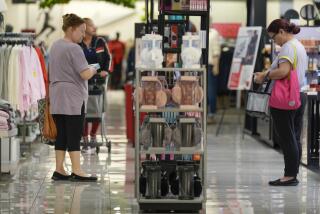July Retail Sales Rise but Wholesale Prices Stay Flat
WASHINGTON — U.S. consumers showed no signs of halting their spending spree in July, but wholesale inflation remained tame, giving the Federal Reserve room to leave interest rates unchanged this month.
Sales at retailers last month grew at the fastest pace since February as consumers spent more on building materials, cars and furniture, the Commerce Department said Friday.
Retail sales rose a stronger-than-expected 0.7% in July to $270.55 billion after a 0.4% rise in June.
With consumer spending acting as the key driver of growth in the sizzling U.S. economy, some analysts said the retail sales figure could spark worries at the inflation-wary Fed.
But in a separate report Friday, the Fed got a reassuring view of inflation. The government said wholesale prices were flat in July, helped by a dip in energy prices.
“The economy continues to expand strongly but inflation remains tame,” Economy.com chief economist Mark Zandi said. The Labor Department said its Producer Price Index, which measures prices paid to factories, farms and other producers, was unchanged in July after a 0.6% gain in June.
Excluding food and energy components, the core index rose just 0.1% after a 0.1% drop in June.
Zandi said the two sets of data encouraged the hope that the giant U.S. economy might achieve a so-called soft landing, where growth moderates to a more sustainable level without risking a recession.
Financial markets largely shrugged off the reports since they did not alter predictions that the Fed would take a wait-and-see approach this month.
Economists noted the retail sales were not worrisome for the Fed when looked at over a long period.
Add that to the wholesale price data and analysts said the Fed’s policymaking Federal Open Market Committee would keep interest rates steady at its meeting Aug. 22. The Fed has raised rates six times in the last 14 months to cool the booming U.S. economy.
“The retail sales rebound was surprising but it still doesn’t rock the boat from the Fed’s point of view,” First Union chief economist David Orr said.
“I don’t look at the bounces so much as the trend and it looks like a good trend,” he said. “There is nothing in here that would cause them to have any ulcers.”
From January to March, retail sales skyrocketed an annualized 13.5% and then slowed to an annualized growth rate of 2.1% from April to June. Orr said he estimated sales growth will likely fit in the range of 5% to 6% from July to August, well within the Fed’s comfort zone.
Excluding car dealers, retail sales in July increased 0.6% after a 0.3% gain in June. Total retail sales last month were up 8.1% from July 1999.
Analysts polled by Reuters had estimated that total retail sales would rise 0.4% in July. Excluding auto sales, analysts had also predicted a 0.4% increase.
Sales of furniture and building materials, which are sensitive to changes in interest rates, each jumped 1.3% in July and sales at car dealers rose 1.1%. That helped fuel an increase in overall spending in durable goods of 1.2%, the sharpest gain since February.
July’s benign producer price inflation reading was helped by a 0.7% drop in prices of finished energy goods.
Over the last year, producer prices have risen 4.1%, although much of that stems from energy prices.
More to Read
Inside the business of entertainment
The Wide Shot brings you news, analysis and insights on everything from streaming wars to production — and what it all means for the future.
You may occasionally receive promotional content from the Los Angeles Times.










